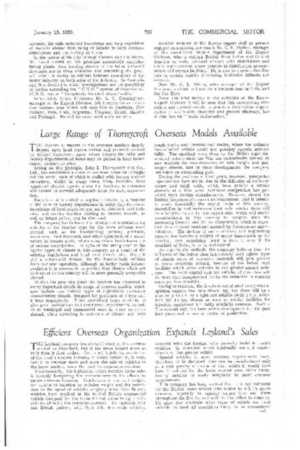Large Range of Thornycroft Overseas Models Available
Page 85

If you've noticed an error in this article please click here to report it so we can fix it.
THE chances of success in the overseas markets largely depend upon local representation and personal contact by trained executives, upon whose reports the sales and factory departments at home may be guided in their future export production plan.
Acting on this principle, John I. Thornycroft and Co., Ltd., has established a chain of overseas branches throughout the world, each of which is stalled with factory trained executives, whilst in many cases these branches have appointed district agents where the territory is extensive and cannot be covered adequately from the 'main organization.
Each branch is visited at regular intervals by a member of the sales or factory departments in order that first-hand knowledge of local requirements can be obtained, and technical and service matters relating to current models, as well as future policy, can be discussed.
The company has followed the principle of manufacturing vehicles of the heavier type for the more arduous work abroad, such as for transporting primary products, machinery, road materials, and other operations of a heavy nature in remote parts, where even minor breakdowns are of serious consequence. In spite of the swing over to the lighter types of chassis in this country, as a result of the existing regulations and legal road speeds, etc., there is still a substantial demand for the heavier-built vehicles from overseas operators, although as better roads become available it is reasonable to predict that chassis which are in demand in this country will be more generally acceptable abroad.
Within the past two years the concern has improved in many important details its range of overseas models, which now include two distinct. types of rigid-frame three-axle cross-country chassis, designed for pay-loads of 3 tons and 6 tons respectively. These specialized types continue to give great satisfaction to Government departments, as well as to municipal and commercial users in many countries abroad, often operating in extremes of ciimate and over
rough tracks and mountainous routes, where the ordinary four-wheeled vehicle could not possibly operate successfully. The excellent work done by the British rigid sixwheeled vehicle since the War has undoubtedly opened ap new markets for manufacturers of both freight and passenger chassis, and in these developments the company has taken an outstanding part.
During the past two or three years, however, unexpected repercussions have set in, due to the difficulty of exchange values and tariff walls, which have proved a serious obstacle at a time when extensive competition has prevailed from foreign manufacturers. However, should the British Government's recent announcement, that it intends to assist financially the export trade of this country, materialize in real assistance (not only words) there will be a brighter future for the export side, which will enable manufacturers in this country to compete with the increasing German and Italian competition, which is organized on a national basis and assisted by Government export subsidies. The 'decline of our machinery and engineering exports has become a subject of major importance to the country, and something must be done at once if the standard of living is to be maintained.
As regards the outlook, the company believes that the influence of the better class individually built lighter types of chassis made of expensive materials will gain ground in many countries abroad, because of the better road facilities which allow vehicles to run greater annual mileages. The extra capital cost for vehicles of this class will be more than compensated for by the reduction in running costs per tare ton-mile.
Owing to taxation, the development of small compressionignition engines has been slowed up, but there will be a promising future for a light and reliable 70-75 b.h.p. 4-litre unit for 4-6-ton chassis as soon as service facilities for injection equipment are easily available overseas. Such a Thornycroft unit has been under development for the past four years and is now in course of production.




















































































































































